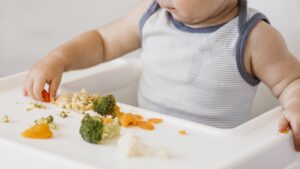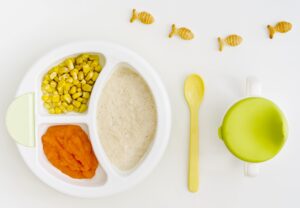Mariella Porter is a Nutritionist registered both in Malta and the UK. She obtained her Master’s degree in Human Nutrition from a UK University, where she studied within the Clinical Sciences Department. In addition, Porter is a lecturer in Nutrition and Health related courses.
Her research work both at master’s and PhD level is in paediatric nutrition, where her main areas of specialisation are food hypersensitivity (allergy and intolerance), and disordered eating. Ms Porter is in fact the author of the document ‘Safety Recommendations on Food Hypersensitivity in Maltese Schools’ and she is very active in promoting the safety of children with food allergies and intolerance.
Ms Porter is also trained and experienced in paediatric weight management and sports nutrition.
Apart from her profession, Mariella is the mother of a young family, where she gives nutrition a priority whilst aiming to strike a balance between work, family and enjoying life!

Skip to a section:
- What is Weaning?
- Spoon versus Baby-Led Weaning
- Which Food to Start From
- How to Proceed from One New Food Introduction to Another and Awareness on Food Hypersensitivity
- When and Where to introduce a new food
- Which Food is not Recommended
- The Benefits of Organic Food
- Feeding milestones up to the age of two
- Meal frequency and portion sizes
What is weaning? When is a Child Ready?
Weaning refers to the introduction of food and drink other than the milk already consumed through breast or formula feeding.
During the first 6 months of life there are changes in the digestive system, where enzymes are produced to digest food and antibodies are produced to protect against germs. Hence an infant’s digestive tract is not fully functional before close to 6 months. In view of this, consumption of food prior close to six months, is not recommended.
There are various indications to when a child is ready for food around the sixth month period, including being able to sit up and hold the head steady, and have hand to eye coordination. In fact, around this period a visit to the paediatrician is recommended where these milestones are assessed together with weight gain, where the weight should be double that at birth. If at the initial stages of weaning, food is constantly pushed out of the mouth, this could be an indication that the child is not physiologically prepared to swallow yet, and one can give some time before presenting food again.
Why is the 4-to-6-month period mentioned for weaning?
Since children develop and grow at a different rate, the period during which food other than milk can be introduced can be extended to the 4-to-6-month period. In fact, according to studies to date, there is no significant harm associated with introduction of complementary foods at 4 months of age, and no significant benefit or harm from delaying complementary foods until 6 months.
Therefore, parents are encouraged to analyse their infant’s development, have it assessed by a paediatrician, and then decide upon the time to introduce food within the 4-to-6-month period.

Spoon versus Baby-Led Weaning
There are two main approaches which one can take when it comes to introducing new foods- spoon-fed and baby-led. Parents might find it hard to decide which feeding method to choose since the media tends to speak in favour or against each of these approaches. Yet put simply, the main difference between baby-led and spoon-fed weaning is the order by which an infant learns own feeding skills.
With the traditional spoon-fed approach, the infant learns how to accept smooth mashed food first, with chewing food at a later stage. On the other hand, through baby-led weaning, where infants are allowed to select finger food, infants can manage lumps and chew from the beginning with the acceptance of smooth food happening later. Latest sound scientific research in paediatric feeding shows that there is no feeding method superior to the other, and that none of the methods chosen can completely solve situations where children might tend to be more picky or fussy around food.
One needs to be careful with baby led weaning in the initial stages in terms of nutrients intake. Most easily graspable foods such as fruits, cooked vegetables and high carbohydrate sources such as crackers and biscuits tend to be low in iron, and hence one needs to ensure these foods are not solely presented for an extended period. In addition, one needs to ensure the child is capable of chewing and swallowing food to avoid choking accidents. On the other hand, throughout the baby led approach the child can learn about satiety prior to the spoon-fed child, and over-feeding or force feeding is avoided. Yet a child-led approach to satiety can also have its negative side in those children who are picky with food or have feeding difficulties, who can end up undernourished.
When it comes to the social aspect of food, self-fed infants may be more advanced at participating at mealtimes. This in turn can create less anxiety and stress on parents and caregivers to provide meal alternatives, and this results in a more positive meal experience.
In view of these pros and cons, one can conclude that there isn’t a better weaning method between the two that fits best for all infants. It is also important to keep in mind that infants are also individuals with their own feeding preferences. Hence, I encourage parents to experiment between these two feeding methods and observe what their child responds better to, from the early feeding stages. In addition, if the spoon method approach is chosen, it is important that this is not extended beyond the recommended time period, where the milestones in feeding will be shared in a future post.
Which Food to Start From
During the very early stages of weaning, the infant is still obtaining the key nutrients through milk. Hence the main aim of the first foods is to expose the child to textures and tastes different to milk. Eventually introduction of additional food fulfils the need to provide key nutrients which help the child meet the increased energy requirements.
Though traditionally there is the practice of starting from baby cereals and/or vegetables and then proceeding to other foods according to the infant’s age in months, latest research shows that there are no specific complementary foods to start from. The American Academy of Paediatrics recommends food sources high in iron and zinc as one of the first food groups, where iron-fortified cereals and pureed meats are a good introduction.
Most traditional views on monthly introduction of food groups base their decision on the idea that certain food groups increase the risk of allergies and/or intolerance if introduce in the early stages of weaning. On the contrary, most recent studies on food hypersensitivity show that kids who are genetically predisposed to food allergies/intolerance, would benefit from not delaying the allergenic food in question, since earlier introduction of food in the 4-to-6 month period, reduces the risk of an immune reaction and increases the chance of the body adjusting to digesting the food protein or other components.
The only food group which is still recommended close to the 1-year period, is cow’s milk. It is well documented that earlier introduction of cow’s milk in liquid form in large volumes can lead to anaemia due to the low iron content in the milk itself, coupled by the possible intestinal blood loss that it causes. In addition, the ratio of other nutrients is not ideal for the first months of the weaning period, and this can lead to dehydration and kidney problems. Yet small amounts of cow’s milk in cooking can be easily tolerated from the early weaning months, and controlled amounts of dairy products such as yogurt and cheese can be consumed earlier than the one-year mark.

How to Proceed From One New Food Introduction to Another and Awareness on Food Hypersensitivity
For those opting for spoon feeding, food can be introduced one at a time. Such introduction allows the infant to get used to the taste and texture of the new food, whilst making it easier to identify the culprit food in case of signs of allergy or intolerance. In this mode of feeding, the food one starts with is pureed to a smooth texture. In this form the texture is closer to the milk the infant is used to, and the chance of acceptance by most infants is increased.
Extending the introduction of the novel food to three to five consecutive days, not only increases the chances of the child accepting the texture and taste, but also makes it easier to identify any allergic or intolerance reactions that can show up when there are multiple consecutive exposures to the same food. A smooth transition to a new food can increase the chances of food acceptance and it can be carried out as follows:
– First exposure: new food just touches the lip
– Second exposure: tip of a teaspoon inside the mouth
– Further exposures: ¼ of a teaspoon, ½ of a teaspoon, ¾ of a teaspoon, 1 full teaspoon.
Once a full teaspoon of food is consumed with no signs of hypersensitivity, the dose should be increased gradually until an age-appropriate full portion size is reached. In the meantime, a new food item is introduced.
Whilst parents/caregivers would prefer to see their child enjoying every sip of new food, it is important that one keeps in mind that any new food introduced tastes and feels very different from the sweet liquidly milk they are used to for months. Hence any facial expressions showing disgust, spitting of food out of the mouth, head turning away from the food, or at times crying, are to be expected especially in the early stages.
To keep food introduction a positive experience, it is also important to speak positively to our children during feeding times. If they exhibit any of the previously mentioned expressions, they are not ‘naughty kids’, but they are expressing themselves in the right way a child should to a new foreign food.

When and Where is the Best Time to Introduce a New Food
With parenthood there is likely never a perfect time! Yet, it is recommended that the introduction of a new food takes place at a time convenient for the parents/caregivers when the infant is fully alert and not cranky. Sometime before mid-morning, preferably close to waking up, is a better time than the early afternoon when the child is tired and ready for a nap. Yet early morning might not be convenient for all parents, especially for those who work outside the house. Hence in such cases mid-afternoon after the child wakes up from a nap and the parent returns from work could be a better option. It is also recommended that when the new food is introduced, the child is hungry enough to likely accept the food more.
An earlier introduction during the day also reduces the risk of a possible allergic reaction happening late into the night, at a time when the parents/carers might not be able to witness the reaction and assist immediately.
With regards to where children are placed during new food introduction, it very much depends on the infants’ character and preferences. Whilst some easily accept sitting in a highchair, others might find being tied in their place very restrictive, some are at their happiest when sitting down on their loved one’s lap, whilst some infants want to feel all grown-up by sitting on an adult chair like everybody else. For the latter group of infants, a chair stool could be helpful.
It is also perfectly fine if not all the food presented ends up in the child’s mouth. Whilst it might look messy for the parents/caregivers, food touching any of the infant’s skin, be it the face, hands or tummy (especially during the summer months when it is more likely that children are more lightly clothed) can enhance food acceptance since there are nerve messages signalling the brain about the foods texture. In view of this, it is also advisable to allow children to play with new food. Example, the child can be provided with a separate plate containing the new food, and this can be used to touch the food and perhaps be more adventurous and guide them on doing hand painting with the new food or drawing funny faces by dipping their index in the food puree.
Hence even when children throw food outside the plate or on the floor, rather than viewing this as negative behaviour, parents and caregivers should understand that the growing infant is on a learning journey about food. In these situations, the reactions of adults caring for the child can have a say in the child’s relationship to new food experiences or mealtimes.

Which Food is not Recommended
Whilst it is advisable to expose children to as many food items from the early stages of weaning, there are some foods which are not recommended. Firstly, there is food which could increase the chance of choking, especially in the early stages of weaning when a child is not capable of chewing properly since the back molars are absent. This includes nuts, peanuts, seeds, chunks of meat or cheese, sausages, whole grapes or cherry tomatoes, hard or sticky candy, popcorn, chunks of peanut butter, raw vegetable sticks, hard dried fruit, jelly cubes, gummies, and hopefully it should go without saying – chewing gum.
Food high in salt and sugar should be avoided from the start. Consumption of these two ingredients is a learnt behaviour, and hence exposure from the early months would only increase the desire for a salty and/or sweet taste in the months and years to follow. When it comes to salt, this should not be used during the cooking process or added to the food before presenting it to the child since excess salt intake can damage the infant’s kidneys. The child can still receive the required salts from a balanced varied diet that includes fruit and vegetables. Hence the following foods should be avoided from the start: bacon, sausages, ham, chips with added salt, salted crackers, crisps, ready meals and takeaways.
When it comes to sugar intake, the latest recommendations about fruit juice consumption are shifting consumption recommendations to after one year of age. When juices are consumed it is still recommended that children are provided those from natural fruit without additional sugar, where the drink is still diluted by adding water to reduce the sugar concentration. This not only reduces the risk of excess weight gain, but also reduces the risk of tooth decay.
In addition, food high in saturated and trans-saturated fat is also not recommended. Hence consumption of processed and/or fast food is not recommended from the early feeding experiences. One should also watch food labelling’s for the amount of saturated fat present in children’s biscuits and sponges. Those which make use of plant oils e.g. sunflower or olive oil, are going to be lower in saturated and trans-saturated fats than those using margarine or butter.
Unpasteurised food carries the risk of containing bacteria which the body of an infant cannot defend well against. Hence unpasteurised food such as honey, some soft cheeses, raw and lightly cooked eggs are not recommended before one year of age. Yet these foods can be included in recipes which require cooking.
Raw or lightly cooked shellfish such as mussels, clams and oysters are also discouraged in the early months since these increase the risk of food poisoning. Whilst fish is recommended for its high-quality protein, vitamins, mineral and healthy fats; large fish such as shark, swordfish and marlin are not recommended due to the high level of mercury which can have a negative impact on an infant’s still developing nervous system.

The Benefits of Organic Food
Organic food is the product of a farming system which avoids the use of man-made fertilisers and pesticides, and if such additives are used, only natural, or non-synthetic alternatives are allowed at the expected dosage. In addition, when it comes to farm animals, growth regulators and feeding additives are avoided, whilst antibiotics are not used for preventative measures.
The word ‘organic’ on a product is protected by law, and its label or logo on a product provides reassurance that a product is truly free from artificial fertilisers and pesticides. In fact, there are strict regulations set to have a food item labelled as organic, with ongoing checks to identify if the farmer or manufacturer is sticking to the labelling.
Since organic products carry significantly lower synthetic pesticide residue than conventional produce, it is a wise choice to present such food especially in the weaning stages and first years of life. Infants and young children could be more susceptible to harm potentially caused by synthetic pesticides and the provision of organic products avoids such a risk.
Having said that it does not mean that all Organic children’s products are a holistically healthier choice for infants and children, especially since some products have a high level of additional sugar, salt, and fat. Hence whilst looking for an organic label on food, parents and caregivers need to be nutrition information savvy, and spot products which are also lower in sugar, salt and fat.

Feeding milestones up to the age of two
Whilst every child reaches feeding milestones at a different rate, the following is an indication of the period during which a child is expected to gain certain feeding skills.
In the first few weeks of the weaning journey, the focus is on exposing the child to various textures and tastes of food, and in the first one or two months the infant is expected to accept the vast majority of food after each food is introduced for several times.
Between the seventh and twelfth month, any liquidised food should be prepared thicker, and there would also be a slow transition to food with tiny lumps eg. yogurt with fruit pieces, and eventually to soft solid food e.g.: boiled vegetables or thin slices of fruit. At this age the child would be able to remove food from spoon with own lips, and swallow it without gagging. This is also the phase when the child can grasp food with own hands, and handling food whist eating should be encouraged.
Close to after one year, children are capable of self-feeding on firmer food e.g.: pasta and bread, and can start drinking from a sippy cup without assistance. This is followed by the ability to hold a spoon alone, scoop food from a bowl or plate, and dip food eg. dipping bread pieces in sauce.
As the child reaches the age of two, s/he is also more capable of moving the spoon to the mouth with limited spilling. This is also the time when meals start resembling more those of the rest of the family. In fact, at this age parents/caregivers should present children with the same food presented to the other family members, with slight adjustments when/if needed.

Meal frequency and portion sizes
Between one to two years of age, young children often eat around five to six times a day, divided as three main meals and two to three snacks. Hence their feeding patterns and timing become more like those of other family members.
When it comes to high carbohydrate foods such as cereals, pasta, and potatoes, three to four portions, the size of the child’s fist when uncooked, are recommended per day. In the case of bread, a portion size is equivalent to the child’s open hand.
These can take the form of a high fibre cereal for breakfast such as oats, wholemeal pasta for lunch and boiled potatoes for dinner. A piece of bread or crackers can be presented as a mid-morning or mid-afternoon snack.
Besides a source of carbohydrates, lunch and dinner should also include a portion of proteins and vegetables. High protein sources can include meat, fish, eggs and beans, where a portion is equivalent to the size of the child’s palm of hand. A variety of different coloured vegetables is encouraged where a portion is equivalent to the size of the child’s hands both open.
The latest paediatric nutrition guidelines use the hands as an indication of what portion sizes should look like. As a child grows, so do his/her hands, and the portion sizes are enlarged with the increase in nutrients requirements.
For snack time fruit, vegetables, cheese, yogurts, and milk are very good sources. A portion of fruit is the size of the child’s fist, vegetables the size of a child’s open hand, cheese the size of the child’s two whole thumb, whilst milk and yogurts the size of the child’s fist.
